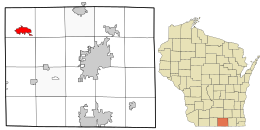Evansville, Wisconsin
| Evansville, Wisconsin | |
|---|---|
| City | |
 Location in Rock County and the state of Wisconsin. |
|
| Coordinates: 42°46′48″N 89°18′1″W / 42.78000°N 89.30028°WCoordinates: 42°46′48″N 89°18′1″W / 42.78000°N 89.30028°W | |
| Country | United States |
| State | Wisconsin |
| County | Rock |
| Area | |
| • Total | 3.31 sq mi (8.57 km2) |
| • Land | 3.25 sq mi (8.42 km2) |
| • Water | 0.06 sq mi (0.16 km2) |
| Elevation | 912 ft (278 m) |
| Population (2010) | |
| • Total | 5,012 |
| • Estimate (2012) | 5,074 |
| • Density | 1,542.2/sq mi (595.4/km2) |
| Time zone | Central (CST) (UTC-6) |
| • Summer (DST) | CDT (UTC-5) |
| Area code(s) | 608 |
| FIPS code | 55-24550 |
| GNIS feature ID | 1564732 |
| Website | www |
Evansville is a city in Rock County, Wisconsin, United States. The population was 5,012 at the 2010 census.
Evansville was first settled in the 1830s by New Englanders who were attracted to the area by its pristine wooded landscape and the placid Allen Creek. By 1855, the city recorded its first plat and was complete with homes, shops, and churches. Evansville is named for Dr. John M. Evans, a doctor and postmaster during the city's early years.
In 1863, the Chicago and North Western Railway came to Evansville, accelerating growth. At this point, Evansville's economy was based on industry and manufacturing of carriages, wagons, pumps, windmills and iron castings. The economy was also based on agriculture: dairying; farming (production of wheat and tobacco); and stock raising.
By the turn of the twentieth century Evansville had over 1900 residents, and by the 1920s, most of the buildings in Evansville's future Historic District were completed.
On November 11, 1918, Armistice Day activities celebrating the end of World War I took an ugly turn as some Evansville citizens began rounding up townspeople who they had deemed insufficiently supportive of the war, mainly due to their refusal or inability to buy war bonds. A German minister and his wife were apprehended on their way out of town before being brought downtown and forced to kiss the American flag. Other "slackers" were made to wear sleighbells as they rode atop a car's radiator, while others were forced to dance in a snake formation around a bonfire. A 73-year-old woman who passed on participating in the "Your Share is Fair" war bond campaign was dragged from her home by the mob, placed in a large animal cage and paraded about the streets before being parked before the fire. The woman, Mary J. Shaw, had previously bought bonds and supported the Red Cross and other war relief efforts. After refusing to salute or kiss the flag she was rescued by other citizens. Her attempts to see her assailants punished were brushed aside by the local sheriff, and testimony before the state legislature was similarly disregarded.
...
Wikipedia
